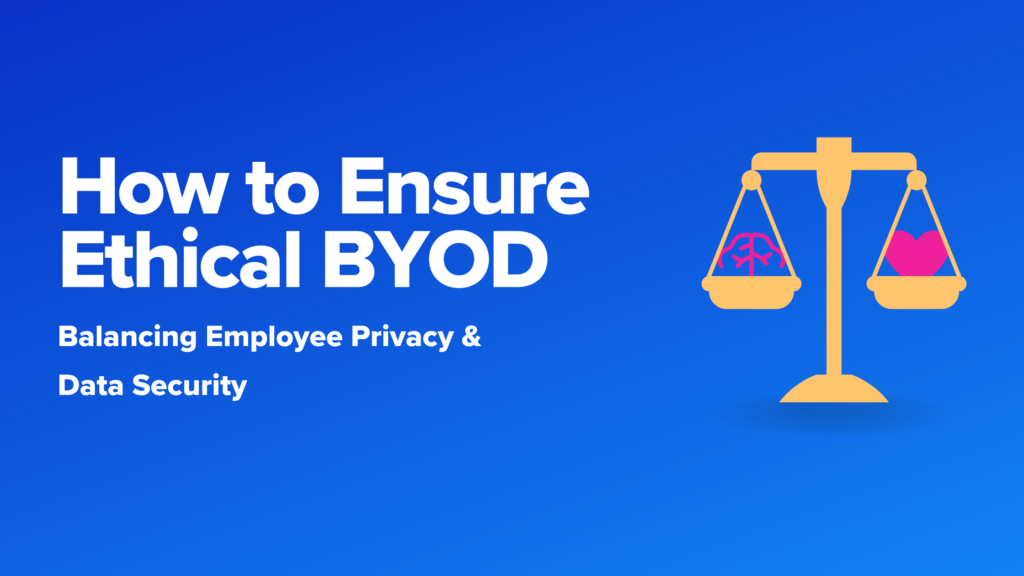Navigating the Ethical Landscape of BYOD: Balancing Security and Privacy

I felt inspired to write this blog because of my experience on the product team at Venn. I’ve had the wonderful opportunity to meet with a myriad of folks and understand the various challenges their organizations are facing while on their quest to better enable their BYOD workforces. Many of these organizations were also investigating strategies to implement a BYOD framework. This is our bread and butter at Venn, so naturally, I really enjoyed these conversations, but what struck me was what was missing from many of these conversations.
BYOD is appealing for several reasons, and typically the conversations and blog posts revolve around the economic and logistical benefits for the business. Leveraging personal devices removes the expense and burden of having to buy, configure, ship and manage devices for a globally distributed workforce. It removes the device loss that is commonplace in the BPO and call center spaces, among many other industries. Then there’s the security conversations. How do you go about securing personal devices for work purposes? There is also a vast amount of information about the secondary positive effects on productivity.
What has been largely missing from the conversations I’ve had is something equally important as everything else: the ethical implications and responsibilities that come with asking employees to use their personal devices for work or giving them the option to do so.
That’s what this blog is looking to explore, and I hope that it inspires you to explore what ethical enablement of BYOD means to you, and how it reflects the values of your organization.
“BYOD Ethics” Definition
As BYOD workforce enablement becomes more integral to your company strategy, considerations beyond just ticking regulatory and data compliance check boxes need to be included. Considerations like protecting what’s in the employees’ best interest and what responsibility, from a moral and ethical perspective, organizations need to assume to ensure the protection of employee privacy and autonomy.
First, it might be helpful to clarify how I’m defining ethics in relation to enabling BYOD. It’s assumed that we want to enable BYOD securely. Ethics in this context are the principles and guidelines that govern the fair, responsible, and respectful use of personal devices for work purposes. This involves balancing the needs for security with productivity and respect for employee autonomy and privacy.
Now that we’ve got our definition, let’s explore some of the ethical challenges we need to contend with.
Challenges
Personal Privacy
This is probably the most important ethical consideration when looking to enable secure work as part of implementing a BYOD initiative. Working from a personal device creates an inevitable overlap between professional and personal. This overlap, typically unintentionally, leads to organizations having access to personal info like photos, messages and browser history. Employees inevitably feel their private lives are under scrutiny, and the fear of being monitored can erode trust and create a sense of constant surveillance, which can have a profound impact on employee morale and productivity.
This fear also directly impacts any plans IT may have had to roll out their chosen solution. The fear of having the company involved in a part of their personal lives uninvited creates tremendous friction that often halts the roll out before it really gets underway. Now, the organization is in a situation where they’re forced to pay for a solution they can’t use, and the seeds of distrust and frustration have been sown amongst the employees. This is not a theoretical story. I’ve heard many times from prospects that their previous attempts to introduce a solution to secure work on personal devices were halted and the solution became shelfware as a direct result of what I’ve just described. Of all the ethical challenges, this is the one you ignore at your peril.
Transparency
Transparency, or the lack thereof, is another ethical challenge to address. Once you’ve settled on a solution, employees need to truly understand what the solution can see on their personal device, what data the company can access as a result and the reasons behind any monitoring that will take place.
Neglecting to adequately address employee transparency needs can lead to mistrust and forceful resistance to BYOD policies. If employees are unaware of or misunderstand the extent of data access and monitoring, they’re going to feel violated and deceived.
Collateral Damage from Cyber Attacks
Another important concern that needs to be addressed is the fact that the employees’ personal devices are now potential collateral damage in the cyber battleground. Imagine a scenario where a hacker targets an employee’s personal device to gain access to corporate networks. If successful, the attacker could also compromise employee’s personal information, such as banking details, private emails, and personal photos.
Criminals targeting high-value individuals that work with sensitive information, in industries like healthcare and finance, aren’t bound by any ethical roadmap that encourages them to only steal and use company-related data from the device. But you do have an ethical obligation to ensure that in the event of a cyber-attack, the impact is minimal to the employee lending their personal device for the needs of the company.
Employee experience
Next up is the user experience. You might be thinking “What does user experience have to do with ethics?”. Ethics entails respect. Respect for the experience of the employee while they work for the organization from their own device. Stay with me here.
Many work-enablement tools, designed from a purely security-centric perspective, often directly impact the usability and performance of personal devices. Security-heavy software can slow them to a crawl, and mandating a litany of apps that must be installed can feel like the company is making itself a little too cozy on personal devices. Employees might find their devices becoming less personal and more like corporate assets, blurring the lines they rely on to maintain separation of work and life.
Other enablement tools try to remove the device from the picture altogether. These tools rely heavily on complex infrastructure that takes time and expertise to tweak for the ideal work experience. They also rely heavily on the employee having a pristine internet connection, which let’s be honest, isn’t a reality for most folks, especially in many popular outsourcing locales.
So now you have employees that are frustrated they can’t work at their best and deliver fast enough. They become fearful that failing to deliver because of the “stupid work security software” will have a direct impact on how they’re perceived by their managers. This creates a ton of stress that really impacts the morale and the mental health of employees.
Alright. Hopefully what you’ve read so far has helped connect the idea that ethics is just as important as economics and security. Let’s now explore a few ideas that can help aid in the ethical implementation of BYOD strategies.
Beyond Security and Compliance: Proactive Ethical Practices for BYOD
Privacy Protection
Look to implement solutions to secure work on personal devices that were designed with safe-guarding employee privacy in mind. This ensures that your employees’ privacy is guarded by default and isn’t just an afterthought.
Why This Matters: Proactively protecting employee privacy builds a solid foundation of trust within the organization. Trust is a major component in employee retention and overall job satisfaction. If employees don’t trust you and the solution, they will revolt, forcing you to turn that solution into expensive shelfware or will look elsewhere for employment.
How to Implement: Choose solutions that inherently limit data access to necessary, work-related information only. Look for solutions that protect privacy without needing a master’s degree in engineering to configure, as complex setups can lead to misconfigurations that expose personal data. Look for features like automatic data segregation and solutions that require minimal permissions on the device.
Inclusivity:
Involving employees in the decision-making process for BYOD solutions is vital. Their feedback and comfort with the solutions will lead to higher adoption rates and satisfaction.
Why This Matters: When employees are included in the decision-making process, they feel valued and respected. This leads to higher engagement and less friction when implementing policies or solutions because employees are more likely to support and adopt tools they helped choose.
How to Implement: Form a committee that includes people from various departments to test and provide feedback on potential solutions. Conduct surveys and focus groups to gather employee input. This can bring to the surface any potential issues early in the process and foster a sense of ownership among employees.
Balance Security and Performance
It’s important to find a balance between security measures and device performance. The right solution should not compromise the usability or efficiency of work applications.
Why This Matters: Striking the right balance between security and performance helps maintain productivity. Employees are more likely to be frustrated and less productive if their devices are slowed down by security measures. Effective solutions should protect data without hindering device functionality.
How to Implement: Test solutions under real-world conditions to confirm they perform well without excessive resource demands. Prioritize solutions that balance security with user experience. Use lightweight security tools that run in the background without slowing down the device. Ensure that critical work apps can function offline or with less-than-ideal internet connectivity.
Simple and Intuitive
BYOD solutions should be easy to use and integrate seamlessly into the daily routines of employees. Avoid solutions that significantly alter how they use their devices.
Why This Matters: Solutions that are simple and intuitive encourage quicker adoption and sustained use. Employees are less likely to be resistant to change or look for workarounds if the tools are easy to learn and integrate smoothly into their existing workflows.
How to Implement: Choose solutions with user-friendly interfaces that mimic familiar workflows. Provide clear instructions and support to help employees adapt.
Transparent Communication
Clear and open communication about BYOD policies and their enablement solutions is essential. Employees need to understand data access policies, the reasons for monitoring, and how their privacy is protected.
Why This Matters: Transparency in communication helps maintain a culture of trust and openness. When employees are fully informed about how their data is handled, they are more likely to comply with policies and feel secure when working on their personal devices.
How to Implement: Regularly communicate policy updates, hold Q&A sessions, and provide detailed documentation about data access and monitoring practices. Create an internal BYOD portal where employees can access all relevant information, ask questions, and provide feedback.
Ethical Leadership and Training
Leadership should model ethical behavior and prioritize privacy protection. Provide ongoing training for both leaders and employees about ethical practices, data security, and privacy rights to embed these values into the organizational culture.
Why This Matters: Ethical leadership sets a positive example and reinforces the importance of privacy and ethical behavior throughout the organization. Consistent training ensures everyone is aware of best practices and the ethical standards expected of them.
How to Implement: Develop and conduct regular training sessions on the ethical use of technology, data protection, and privacy rights. Leaders should participate in training sessions alongside employees to demonstrate their commitment to the principles being taught.
Employee Empowerment
Empowering employees with the knowledge and tools to manage their privacy and security is key. Provide resources and support to help them navigate the complexities of BYOD.
Why This Matters: Empowering employees ensures they are proactive in managing their own privacy and security alongside the company’s proactivity.
How to Implement: Provide resources such as how-to guides, online training modules, and access to security tools that employees can use on their devices. Create a dedicated support team that employees can contact for help with BYOD specific issues, ensuring they have the support they need to manage their devices for the demands of work.
—
BYOD strategies can be a game-changer for organizations and employees, especially when ethics guides the company’s strategies in its enablement. If you’re responsible for finding the solution that will enable secure BYOD for your organization, look beyond just security and ask yourself if you’d feel comfortable with that solution sitting on your personal laptop. If the answer is not quite, keep looking. There are options out there that will help you find the right balance between what the organization needs and what’s best for those doing the day-to-day work.
Venn is one of those options. It’s a solution designed by privacy-oriented people who believe in a better way of working. Venn enables organizations to implement their BYOD strategy without violating privacy, radically changing the computer experience, slowing down devices, or compromising security. If you’re looking for a secure, compliant solution that’s radically different from the traditional and won’t frustrate your workforce, let’s talk. We’d love to show you a new way to work.
More Blogs

In my previous blog I discussed the impact the 2nd Digital Transformation is having on IT teams andd employee computing experiences around the globe. Understanding this massive shift from the perspective of IT leadership is all well and good, but what does this transformation look like from an employee standpoint? In other words, how are […]

As a Senior Product Owner here at Venn I get asked a variety of questions about our secure remote workspace, often revolving around the same concepts or fundamental aspects of the product. With most users accustomed to slow, clunky legacy VDI experiences, Venn’s unique set of features and capabilities represent deviations from the way most […]

The COVID-19 pandemic forced organizations around the world to rapidly design remote work programs that both protected their employees and ensured business continuity in turbulent economic times. From the onset of this shift to dispersed organization structures business leaders around the world naturally assumed that it was to be a disruption, not a complete reset, […]